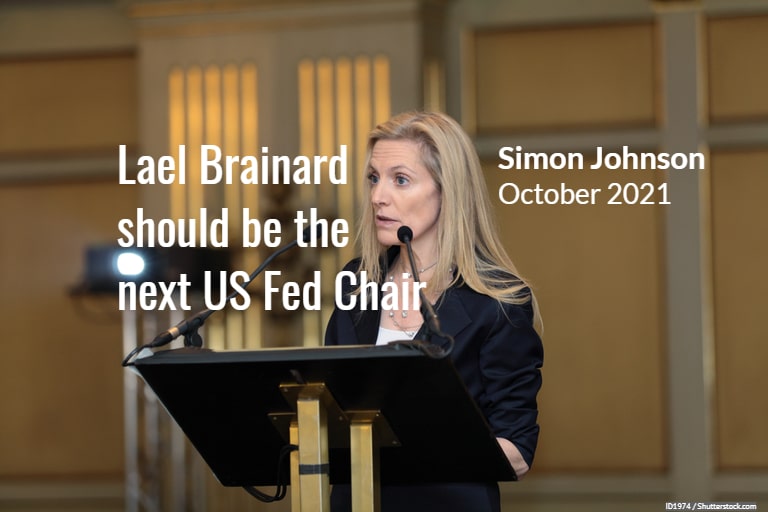By Simon Johnson, former chief economist at the IMF, Professor at MIT
A major debate is in the making – or, more accurately, beginning to be reopened – in the United States about the appropriate objectives and triggers for monetary policy in the modern American economy. The stakes are enormous, including whether prosperity in the US can really become more inclusive – and who should lead the Federal Reserve in 2022 and beyond.
One vision comes from Lael Brainard, a member of the Federal Reserve Board of Governors since 2014, who on September 27 reiterated her compelling case for not prematurely raising interest rates in a pandemic-damaged economy. Jobs are coming back, but the recovery is slow and erratic. The Delta variant did real damage, on top of the deep disruption caused by previous COVID-19 waves. Among other problems, continuing or repeated school closures and major childcare shortages mean that many parents cannot yet return to work in person.
As Brainard emphasizes, “the pandemic has taken a significant toll on the labor market status of many mothers, particularly Black and Hispanic mothers, mothers with younger children, and mothers with lower incomes.” We are far from genuinely full or maximum employment.
In the other corner is… well, we’ll see. During a major debate about monetary policy in 2015, Governor (now Chair) Jerome “Jay” Powell was among those who favored earlier tightening – in marked contrast to Brainard’s preference to keep rates low to achieve full employment. According to recently released transcripts, Powell was consistent in his pro-tightening views. As early as 2013, he was telling then-Chair Ben Bernanke and his colleagues, “we’ve got to jump” (tighten monetary policy). Bernanke’s 2015 memoir confirms that Powell emphasized the need for an “off-ramp” for monetary policy, and this may have been Powell’s view since 2012, when he joined the Fed board.
The issue back then was how to think about inflation risks and the potential costs of tightening policy too early, particularly for employment prospects for low-wage Americans. We face the same issue today. Brainard’s argument has consistently been that it is premature to raise interest rates until inflation accelerates and stays high. Short-term price movements due to temporary factors should be ignored.
What really stands out in Brainard’s view is the weight she places on labor-market outcomes for people who are at the “margins” of the economy, in the sense that they are the first to be laid off in an economic downturn and the last to be rehired in a recovery. Many of these people are women, among whom women of color are frequently hit the hardest when the economy stagnates or contracts.
When Brainard first articulated the importance of a more holistic assessment of employment outcomes and prospects, her argument was regarded with skepticism by the (mostly) men who run monetary policy in the US and other developed countries. The long-established tradition among this group, particularly Fed governors appointed by Republican administrations, has been to prefer acting “preemptively” against inflation. Traditionally, Republican appointees and their congressional supporters are more inclined to support tighter monetary policy when there is a Democratic president in office – in line with long-standing findings about political preferences.
Since 2015, however, Brainard’s view has become widely accepted in policy circles, effectively forming the basis for the Fed’s “new framework” in August 2020 – a notable shift in official thinking for which she often receives insufficient credit. It is particularly noteworthy that Brainard persuaded so many of her male colleagues – the six current governors include two women, while the chair and two vice chairs are men – to adopt her perspective, at least for now.
There are two main scenarios for US monetary policy in the coming months and years. The first is that the new framework will continue to prevail along the lines Brainard originally envisioned and restated in her September 27 speech. In that case, payroll employment should increase by 5-8.5 million – where it would have been, according to Brainard, “in the absence of the pandemic” – while inflation will remain under control.
The second scenario is that some combination of the five Republican-appointed Governors will lead the charge to tighten monetary policy before the economy is fully recovered. The latest economic projections from the Federal Open Market Committee already indicate movement in a hawkish direction, toward tightening monetary policy. If this view prevails, led by Powell or someone else, expect slower job growth and worse labor-market outcomes (fewer hours worked, lower wages) for groups that have traditionally not done well in downturns.
Thinking about what comes next, it is also significant that Brainard is among the few policymakers who have said that the 2015-18 interest rate hikes were a mistake in retrospect. Powell has made no such statement.
There is one obvious way to ensure that Brainard’s vision for a more inclusive economy prevails: Appoint her as Fed chair when Powell’s term expires in February 2022.
Simon Johnson is a former chief economist at the International Monetary Fund, Professor at MIT’s Sloan School of Management and a co-chair of the COVID-19 Policy Alliance
©Project Syndicate 2021
Note: The views expressed in this article are the author’s, and not the position of Intellectual Dose, or iDose (its online publication). This article is republished with permission from project syndicate.




Pingback: The most Powerful Banker in the World should be Fired - iDOSE